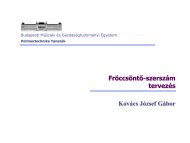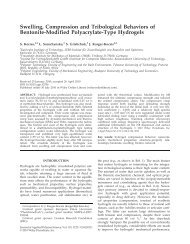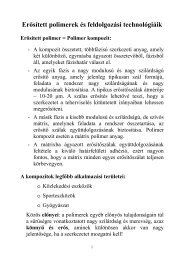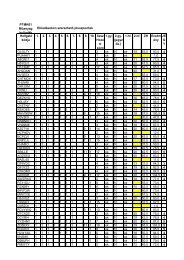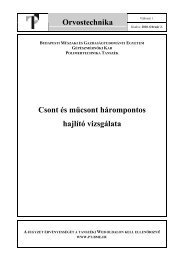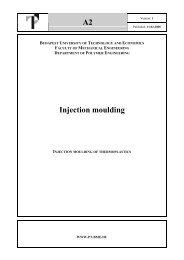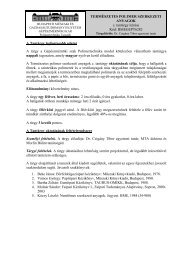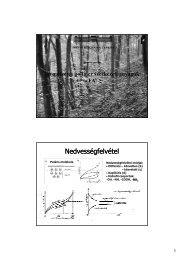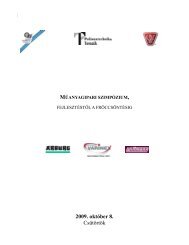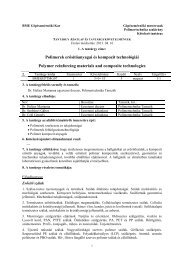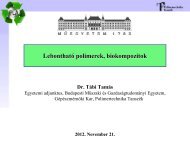Flexural creep of all-polypropylene composites: Model analysis
Flexural creep of all-polypropylene composites: Model analysis
Flexural creep of all-polypropylene composites: Model analysis
Create successful ePaper yourself
Turn your PDF publications into a flip-book with our unique Google optimized e-Paper software.
The long-term <strong>creep</strong> behavior may be predicted fromshort-term <strong>creep</strong> data by applying the time-temperaturesuperposition (TTS) principle. The premise <strong>of</strong> TTS is thattemperature accelerates the <strong>creep</strong> deformation kinetics.Hence <strong>creep</strong> curves at different temperatures may beshifted along the logarithmic time axis until they superimposeto form <strong>creep</strong> master curve extending to much longertimes than the short term data. The validity <strong>of</strong> TTSmust be established by long-term tests but is nonethelessuseful for obtaining a general description <strong>of</strong> the material’slong-term behavior [29, 30].FIG. 1.Schematic representation <strong>of</strong> the four-element Burger model.Kelvin dashpot respectively, s is the applied stress andt is the <strong>creep</strong> time.Besides the constitutive models, empirical or mathematicaldescriptions have also been widely studied [7]due to their simple expression and satisfactory simulationor prediction capability. Among these, the Findley powerlaw model is commonly accepted. The constitutive equationproposed by Findley is simplified in the followingform [7, 28]:e F ¼ e 0 þ e c t n : (6)Here n is a dimensionless material parameter, e 0 is the instantaneousor time-independent strain (functions <strong>of</strong> stressand environment variables including temperature, moisture,etc.), and e c is the time-dependent term. The symbolt may be taken to represent a dimensionless time ratiot/t 0 , where t 0 is the unit time. e 0 , e c , and n are <strong>creep</strong>parameters and each can be assigned a numerical valueby experiment<strong>all</strong>y measuring the instantaneous and timedependentcompliance <strong>of</strong> a viscoelastic material and thencalculating the values from Eq. 6. Because <strong>of</strong> the oversimplification<strong>of</strong> this model (it does not take into considerationthe changes in the shape <strong>of</strong> the material), thevalues calculated from the above equation cannot beunivers<strong>all</strong>y applied. The shape <strong>of</strong> a material depends onmolecular mobility and is a function <strong>of</strong> the microstructureand molecular alignments during the processing <strong>of</strong> materialsand the shape from sample to sample can be influencedby other external factors such as moisture content,humidity, and temperature. Since <strong>all</strong>-PP <strong>composites</strong> likeother viscoelastic materials are very much influenced bythe factors as detailed above, the parameters obtainableby the power law model can only give an approximation<strong>of</strong> the real behavior. Nevertheless, it is expected that thismodel can be used as a first hand tool to predict the longtermdeformation behavior <strong>of</strong> <strong>all</strong>-PP <strong>composites</strong>.EXPERIMENTALIn this study, commerci<strong>all</strong>y available <strong>all</strong>-PP (PURE 1 )coextruded tapes, obtained from Lankhorst-Indutech B.V.(Sneek, The Netherlands), was used to make the unidirectional(UD) and cross-ply (CP) laminates. The PP tapeshave a skin-core-skin (A-B-A) morphology with PPhomopolymer as the core and a random PP copolymer asthe skin layer. The other characteristics <strong>of</strong> these coextrudedtapes are available in the literatures published earlier[31, 32].The manufacture <strong>of</strong> <strong>all</strong>-PP <strong>composites</strong> involved a twostageprocess—winding <strong>of</strong> the PP tapes, [both unidirectional(08) and cross-ply (08/908)], and consolidation <strong>of</strong>the fabric plies at a suitable temperature and pressure inan autoclave. For winding the tapes, a filament windingtechnique was adopted. A detailed description <strong>of</strong> the compositemanufacture is available in the references [31, 32].<strong>Flexural</strong> <strong>creep</strong> tests were performed using three-pointbending mode at temperatures ranging from 208C to808C, in the same DMA Q800 apparatus. Isothermal testswere run on the specimens by increasing the temperaturestepwise by 108C. Before the <strong>creep</strong> measurement, thespecimens were equilibrated for 5 min at each temperatureand then the flexural <strong>creep</strong> behavior was tested for30 min. All the tests were performed under a constantload <strong>of</strong> 10 MPa. Test specimens <strong>of</strong> dimensions 60 3 153 1.8 mm 3 (length 3 width 3 thickness) were employedfor <strong>creep</strong> studies and the average <strong>of</strong> three statistic<strong>all</strong>yrelevant <strong>creep</strong> data has been reported for each kind <strong>of</strong>specimen.To determine the cryst<strong>all</strong>inity <strong>of</strong> the <strong>all</strong>-PP <strong>composites</strong>,differential scanning calorimetric (DSC) investigationswere performed before and after the <strong>creep</strong> tests using aMettler-Toledo DSC 821 instrument (Greifensee, Switzerland).The cryst<strong>all</strong>inity contents <strong>of</strong> the <strong>composites</strong> werecharacterized from the enthalpy <strong>of</strong> fusion associated inthe first heating run. Heating scans were performed from258C to 2008C at a heating rate <strong>of</strong> 108C/min with nitrogenblanketing inside the sample chamber. An average <strong>of</strong>three specimens was taken for each <strong>of</strong> the specimens.The cryst<strong>all</strong>inity was then determined by taking the ratio<strong>of</strong> the enthalpy <strong>of</strong> fusion <strong>of</strong> the <strong>all</strong>-PP composite to theenthalpy <strong>of</strong> fusion <strong>of</strong> 100% cryst<strong>all</strong>ine PP taken as207.1 J/g [33].DOI 10.1002/pen POLYMER ENGINEERING AND SCIENCE—-2008 943




